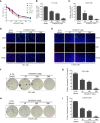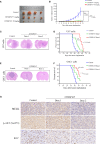Corrigendum: MELK Inhibition Effectively Suppresses Growth of Glioblastoma and Cancer Stem-Like Cells by Blocking AKT and FOXM1 Pathways
- PMID: 35530328
- PMCID: PMC9074389
- DOI: 10.3389/fonc.2022.911817
Corrigendum: MELK Inhibition Effectively Suppresses Growth of Glioblastoma and Cancer Stem-Like Cells by Blocking AKT and FOXM1 Pathways
Abstract
[This corrects the article DOI: 10.3389/fonc.2020.608082.].
Keywords: OTSSP167; glioblastoma multiforme; glioblastoma stem-like cells; maternal embryonic leucine-zipper kinase; targeted therapy.
Copyright © 2022 Zhang, Wang, Wang, Liu, Li, Yu, Wu, Liang, Yu and Liu.
Figures



Erratum for
-
MELK Inhibition Effectively Suppresses Growth of Glioblastoma and Cancer Stem-Like Cells by Blocking AKT and FOXM1 Pathways.Front Oncol. 2021 Jan 14;10:608082. doi: 10.3389/fonc.2020.608082. eCollection 2020. Front Oncol. 2021. PMID: 33520717 Free PMC article.
Similar articles
-
MELK Inhibition Effectively Suppresses Growth of Glioblastoma and Cancer Stem-Like Cells by Blocking AKT and FOXM1 Pathways.Front Oncol. 2021 Jan 14;10:608082. doi: 10.3389/fonc.2020.608082. eCollection 2020. Front Oncol. 2021. PMID: 33520717 Free PMC article.
-
Inhibition of maternal embryonic leucine zipper kinase with OTSSP167 displays potent anti-leukemic effects in chronic lymphocytic leukemia.Oncogene. 2018 Oct;37(41):5520-5533. doi: 10.1038/s41388-018-0333-x. Epub 2018 Jun 12. Oncogene. 2018. PMID: 29895969
-
Maternal embryonic leucine zipper kinase: key kinase for stem cell phenotype in glioma and other cancers.Mol Cancer Ther. 2014 Jun;13(6):1393-8. doi: 10.1158/1535-7163.MCT-13-0764. Epub 2014 May 2. Mol Cancer Ther. 2014. PMID: 24795222 Free PMC article. Review.
-
Maternal embryonic leucine zipper kinase is a key regulator of the proliferation of malignant brain tumors, including brain tumor stem cells.J Neurosci Res. 2008 Jan;86(1):48-60. doi: 10.1002/jnr.21471. J Neurosci Res. 2008. PMID: 17722061
-
Enigmatic MELK: The controversy surrounding its complex role in cancer.J Biol Chem. 2020 Jun 12;295(24):8195-8203. doi: 10.1074/jbc.REV120.013433. Epub 2020 Apr 29. J Biol Chem. 2020. PMID: 32350113 Free PMC article. Review.
Publication types
LinkOut - more resources
Full Text Sources
Miscellaneous

